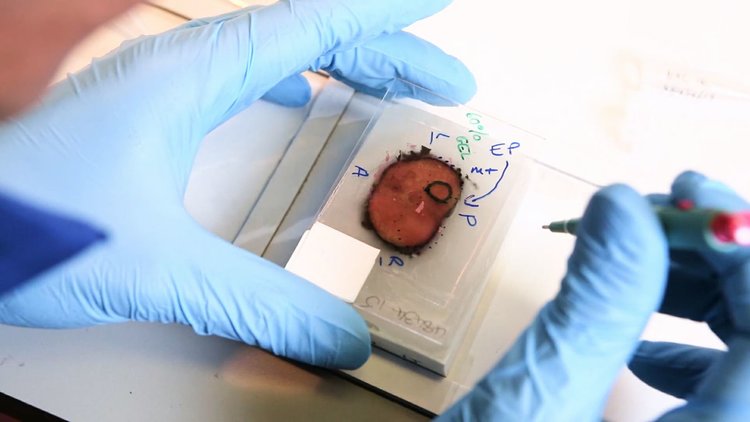Introduction of Archived FFPE Blocks
The morphology and cellular details of tissues can be well preserved using formalin fixation and paraffin embedding (FFPE). It is the standard preservation procedure for specimens that are used in a wide range of fields such as research and diagnostic surgical pathology. FFPE blocks are cost efficient as they can be stored long term at an ambient temperature when compared to the alternative where frozen tissues have to be stored at ultra-low temperatures which increases the cost of maintenance, space, and labor required. Due to the cost efficiency, many pathology departments archive many FFPE tissue blocks. This makes FFPE blocks an untapped resource with the potential of extensive tissue material that is a valuable resource in the field of translational clinical research.
FFPE blocks has also been accepted for its value in the field of immunohistochemistry (IHC) since 1991. The antigen retrieval techniques in the extraction of DNA, RNA, and proteins from FFPE blocks allows the preservation of the molecules and morphology in cell samples. The advances in molecular biotechnology has also allowed the extraction of nucleic acids and proteins from these FFPE blocks which can then be utilized in downstream applications.
The proteins extracted from FFPE blocks has many uses such as in:
· Western blot analysis
· Reverse phase arrays
· Surface enhanced laser desorption
The DNA isolated from FFPE blocks are highly fragmented but can be successfully used in shorter amplifications up to 250bp in length. Even if the samples are partially degraded, it is suitable for downstream analysis using the polymerase chain reaction (PCR) procedure and sequence specific oligonucleotide (SSO) probe procedures. The RNA obtained can be used in gene expression analysis. Both the DNA and miRNA are currently being used in the search for biomarkers. The peptides from extracted proteins can also be used in mass spectrometry analyses to help to understand the molecular mechanism of diseases.
In the last decade, there has been a dramatic increase in molecular assay development by using FFPE blocks. Currently, when FFPE blocks are used in molecular extraction, specific attention is paid to formalin fixation time to ensure that over-fixation does not occur. Analysis of larger cohort samples are increasingly required to study various biomarkers that are being used in targeted therapies and to deliver prognosis. This highlights the value of archived FFPE blocks as a readily available resource to meet the current needs.
There is increasing interest whether the storage period of FFPE blocks would affect the extracted macromolecules. This is due to the residual formalin within FFPE blocks that may continue to react with the tissues during storage. The analysis of DNA is therefore the first step which is crucial to acquire meaningful data from the FFPE specimens. A study by Kokkat et al, 2013, shows that DNA extracted from tissues that are 11 to 12 years old, 5 to 7 years old, and 1 to 2 years old, are all comparable to the quantity and quality of DNA that are extracted from FFPE blocks less than a year old. In this study, the research team used frozen tissues that do not have matching storage periods with the FFPE tissues to reflect the scenario where there is a large reserve of FFPE tissues while frozen tissues are collected prospectively. They extracted DNA and RNA from the same set of tissues and observed that there is a wide range in the concentration of the molecular derivatives. They attributed it to the fact that about 71% of the samples contain tumor cellularities that range from 40% to 100%. While there was greater protein fragmentation seen in the FFPE tissue blocks that were stored for more than 5 years, this finding suggests that older FFPE blocks to be used in fit for purpose studies. The research team believe that this may be due to the modifications of protein from the formalin fixation. During the analysis of formalin fixed synthetic homo-oligo RNAs, they observed that there is a reaction between formaldehyde and nucleotide monomers that eventually results in a formaldehyde group being added to a base in the form of N-methylol. There is then an electrophilic attack on the N-methylol on an amino base that leads to the formation of a methylene bridge between the two amino groups.
Conclusion
Archived FFPE tissue blocks represents a large resource as FFPE blocks that have been stored up to 12 years are still extremely useful and can be used in the adequate and usable extraction of DNA, RNA, and protein. The study by Kokkat et al, 2013 have proven the value of archived FFPE tissue blocks as they showed that all three macromolecules (DNA, RNA, and proteins) can be extracted from the same FFPE block that has been stored for many years. This is a valuable finding as it can be useful in the analysis of cases where there is limited tissue available for biomarker studies to deliver prognosis and tailored therapies.
References:
Kokkat TJ, Patel MS, McGarvey D, LiVolsi VA, Baloch ZW. Archived formalin-fixed paraffin-embedded (FFPE) blocks: a valuable underexploited resource for extraction of DNA, RNA, and protein. Biopreserv Biorepository 2013; 11(2): 101-106.




